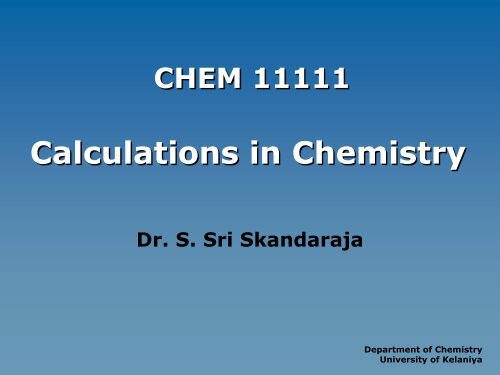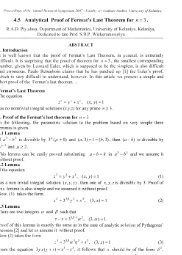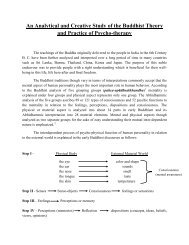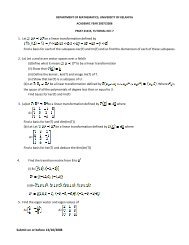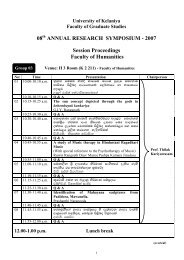CHEM 11111_2013_05_20 - University of Kelaniya
CHEM 11111_2013_05_20 - University of Kelaniya
CHEM 11111_2013_05_20 - University of Kelaniya
You also want an ePaper? Increase the reach of your titles
YUMPU automatically turns print PDFs into web optimized ePapers that Google loves.
<strong>CHEM</strong> <strong>11111</strong><br />
Calculations in Chemistry<br />
Dr. S. Sri Skandaraja<br />
Department <strong>of</strong> Chemistry<br />
<strong>University</strong> <strong>of</strong> <strong>Kelaniya</strong>
Logarithms<br />
10 n Number = base exponent<br />
When base is 10 then ‘n’ is the logarithm <strong>of</strong><br />
‘N’.<br />
n = log 10 N<br />
log 10 10 = 1<br />
log 10 1000 = 3<br />
log 10 0.001 = -3
The concept <strong>of</strong> pH<br />
pH = -log[H + ]<br />
The H + concentration <strong>of</strong> a acid<br />
solution is 0.<strong>05</strong>3 M.<br />
Calculate the pH <strong>of</strong> the solution.<br />
pH = -log [H+] = - log (0.<strong>05</strong>3)<br />
= - (-1.27572413…..)<br />
Accurate pH value<br />
= 1.28
The pH <strong>of</strong> a solution is 10.5<br />
Calculate the OH - concentration <strong>of</strong><br />
the solution.<br />
pH = -log [H + ] = 10.5<br />
Hence pOH = 3.5 = - log [OH - ]<br />
[OH - ] = antilog 10 (-3.5)<br />
= 3.1622776…..x 10 -4<br />
Accurate [OH - ] value<br />
= 3 x 10 -4 M
log MN = log M + log N<br />
log M/N = log M - log N<br />
eg. k a = [H + ][A - ] / [HA]<br />
hence<br />
pH <br />
pk<br />
a<br />
<br />
[ A ]<br />
log<br />
[ HA ]<br />
log M p = p log M<br />
log [H + ] 4 = 4 log [H + ]<br />
= -4pH<br />
Henderson-Hasselbalch equation<br />
K b ??
Natural logarithms (ln)<br />
e n<br />
Number = base exponent<br />
n = log e N = ln N<br />
2.718<br />
ln MN = ln M + ln N<br />
ln M/N = ln M - ln N<br />
ln M p = p ln M<br />
ln (1) = 0<br />
‘e’ has a value <strong>of</strong>
Eg. in chemistry ( thermodynamics)<br />
DG o = -RT ln K or DG = DG o + RT ln K<br />
Eg.<br />
If the equilibrium constant <strong>of</strong> a reaction is 4.6 x 10 3 at a<br />
temperature <strong>of</strong> 298 K, calculate the change in standard<br />
Gibbs free energy for the reaction at this temperature<br />
( R= 8.314 J K -1 mol -1 ).<br />
Answer<br />
= <strong>20</strong>895.374…<br />
significant figures ?<br />
= 2.1 x 10 4<br />
Units?
Nernst equation<br />
Ox +ne<br />
Red<br />
E<br />
<br />
E<br />
0<br />
<br />
RT<br />
nF<br />
ln<br />
[Re d]<br />
[ Ox]<br />
R= gas constant = 8.314 J mol -1 K -1<br />
T= temperature = 298.1 K (25 0 C)<br />
n = number <strong>of</strong> electrons transferred in the half cell reaction<br />
F = Faraday’s constant = 96490 C<br />
E = reduction potential<br />
Fe 3+ + e Fe 2+ E 0 Fe3+/Fe2+=+0.68 V
If log 10 P = q<br />
P= 10 q<br />
Hence<br />
ln P = ln 10 q<br />
= q ln 10<br />
But ln 10 = 2.303<br />
Hence ln P = 2.303 log 10 P<br />
E<br />
<br />
E<br />
0<br />
<br />
RT<br />
nF<br />
ln<br />
[Re d]<br />
[ Ox]<br />
• At 298.1K (25 0 C): 2.303 RT/F= 0.<strong>05</strong>92<br />
E cell<br />
<br />
E<br />
0<br />
<br />
2.303RT<br />
nF<br />
log<br />
[Re d]<br />
[ Ox]<br />
E cell<br />
<br />
E<br />
0<br />
<br />
0.<strong>05</strong>92<br />
n<br />
log<br />
[Re d]<br />
[ Ox]
Eg. in chemistry ( Kinetics)<br />
rate = k [reactants] n<br />
log(rate) = log(k) + n log [reactants]<br />
log (rate)<br />
log [reactants]
Eg. in chemistry ( Kinetics)<br />
First order rate law<br />
[A] = [A 0 ] e -kt<br />
t = time<br />
[A] = concentration <strong>of</strong> A at time ‘t’<br />
[A 0 ] = initial concentration <strong>of</strong> A<br />
k = Rate constant<br />
ln[A] = ln[A 0 ] – kt
Eg. in chemistry ( Kinetics)<br />
Arrhenius Equation<br />
k = A e -Ea/RT<br />
T= temperature<br />
A = Arrhenius constant or pre-exponential factor<br />
E a = activation energy<br />
R = universal gas constant<br />
k = rate constant<br />
ln k = ln A - E a /RT<br />
y = c + mx
Another definition.<br />
e x<br />
1<br />
x<br />
<br />
x<br />
2<br />
2!<br />
<br />
x<br />
3<br />
3!<br />
<br />
x<br />
4<br />
4!<br />
.....<br />
If x is very small.<br />
e x 1<br />
x
Using Calculators<br />
To get<br />
• log<br />
•Anti-log<br />
•ln<br />
•Anti-ln (e)<br />
•EXP key<br />
?
Trigonometric functions<br />
b<br />
a<br />
tana<br />
<br />
sina <br />
cosa <br />
tana <br />
a<br />
b<br />
<br />
a<br />
c<br />
b<br />
c<br />
a<br />
b<br />
sin<br />
cos<br />
a<br />
a
2<br />
2<br />
2<br />
c<br />
b<br />
a<br />
<br />
<br />
c<br />
a<br />
<br />
sina<br />
2<br />
2<br />
2<br />
)<br />
(sin<br />
a<br />
c<br />
<br />
a<br />
c<br />
b<br />
<br />
cosa<br />
2<br />
2<br />
2<br />
)<br />
(cos<br />
b<br />
c<br />
<br />
a<br />
2<br />
2<br />
2<br />
2<br />
2<br />
)<br />
(cos<br />
)<br />
(sin<br />
c<br />
c<br />
c<br />
<br />
<br />
a<br />
a<br />
1<br />
)<br />
(cos<br />
)<br />
(sin<br />
2<br />
2<br />
<br />
<br />
a<br />
a
Values <strong>of</strong> trigonometric function<br />
‣Cosecant(cosec)<br />
hypotenuse/opposite side<br />
‣cosec = c/a<br />
‣Secant(sec)<br />
hypotenuse/adjacent side<br />
‣sec = c/b<br />
‣Cotangent(cot)<br />
adjacent side/opposite side<br />
‣cot = b/a<br />
17
Some important relationships<br />
‣ sin 2 A + cos 2 A = 1<br />
‣ 1 + tan 2 A = sec 2 A<br />
‣ 1 + cot 2 A = cosec 2 A<br />
‣ sin(A+B) = sinAcosB + cosAsin B<br />
‣ cos(A+B) = cosAcosB – sinAsinB<br />
‣ tan(A+B) = (tanA+tanB)/(1 – tanAtan B)<br />
‣ sin(A-B) = sinAcosB – cosAsinB<br />
‣ cos(A-B) = cosAcosB+sinAsinB<br />
‣ tan(A-B) = (tanA-tanB)(1+tanAtanB)<br />
‣ sin2A = 2sinAcosA<br />
‣ cos2A = cos 2 A - sin 2 A<br />
‣ tan2A = 2tanA/(1-tan 2 A)<br />
‣ sin(-A) = sin (A)<br />
‣ Cos(-A) = Cos(A)<br />
‣ Tan(-A) = Tan(A)
Values <strong>of</strong> Trigonometric function<br />
0 30 45 60 90<br />
Sine 0 0.5 1/2 3/2 1<br />
Cosine 1 3/2 1/2 0.5 0<br />
Tangent 0 1/ 3 1 3 Not defined<br />
Cosecant<br />
Not<br />
defined<br />
2 2 2/ 3 1<br />
Secant 1 2/ 3 2 2 Not defined<br />
Cotangent<br />
Not<br />
defined<br />
3 1 1/ 3 0
X-Ray Diffraction: Bragg’s Law<br />
2d sin = nl<br />
Extra distance<br />
traveled by wave 2<br />
= 2d sin


